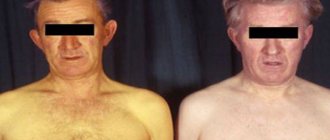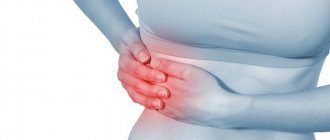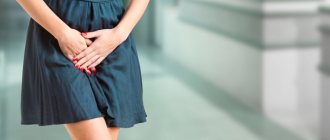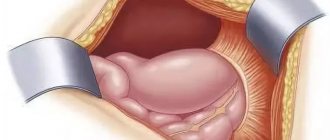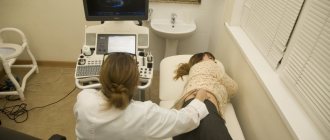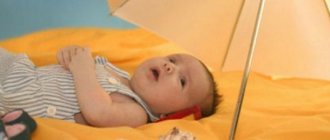Main causes of lower back pain
Unfortunately, many people try to get rid of back pain on their own without knowing exactly its source. Erroneously assuming that the paravertebral muscles are overloaded, patients take a steam bath and rub in warming ointments. Such self-medication can be dangerous to health. Lumbar pain often indicates inflammation and tumors of the digestive, urinary, and reproductive systems. From the back, pain in the ribs can occur due to neurological disorders, spinal deformities, and heart failure. Visceral pain is carried out by sympathetic fibers that innervate the internal organs. The signal arrives along the spinal projection tracts - from the spinal cord to the central nervous system. The main triggers for the occurrence and transmission of a pain impulse are a sudden increase in pressure in hollow organs or stretching of their walls (fibrous capsules).
Shpidonov Gennady Stanislavovich
Neurologist
Rostov State Medical University (neurology)
10 years of experience
Gastrointestinal tract
Relapse of chronic diseases leads to irritation of the nerves innervating the gastrointestinal tract. Pain in the ribs appears during exacerbation of:
- Stomach ulcers. The disease develops due to damage to the mucous membrane by Helicobacter pylori bacteria, as well as against the background of alcohol abuse, stress, unhealthy diet, and advanced hyperacid gastritis. Particularly intense pain is caused by a penetrating (complicated) ulcer involving adjacent tissues.
- Pancreatitis is inflammation of the pancreas (PG). The pain covers the epigastrium, left hypochondrium, extends under the scapula, into the left arm, intensifies after eating, in a lying position, often accompanied by febrile temperature (38-39℃), stool upset, increased gas formation, nausea with the release of vomit containing bile.
Triggers for the development of inflammation can be gallstones, advanced duodenal ulcers, and alcoholism. You can get sick due to incorrect intake of steroid hormones, addiction to foods rich in animal fats.
Oncological tumor of the pancreas
Cancer of the head of the pancreas is painful. The neoplasm is localized primarily in the ducts, and as it grows, it compresses the nerves, causing intense pain in the upper half of the abdomen, radiating to the lower back.
Intestines
Sacrodynia - aching, referred pain at the lumbosacral level is initiated by colitis or enterocolitis. Both diseases are associated with inflammatory processes occurring in the intestines. Severe pain is observed during an attack of appendicitis. Especially if the inflamed appendix of the cecum (appendix) has a low or retrocecal, that is, posterior anatomical location. In addition, sacrodynia is a concern in cases of cancer and mucocele of the appendix - an abnormal expansion of the lumen of the appendix with excessive accumulation of mucus.
Intercostal neuralgia
Spinal pain (dorsalgia) begins suddenly, like a “lumbago”, spreading along the thoracic spinal nerves, encircling the body. The intensity of sensations increases sharply with any twisting of the torso, coughing, or taking a deep breath. Strong pain in the pit of the stomach, under the shoulder blades, in the lower back. The cause of back pain under the ribs is:
- neuromuscular inflammation, against the background of reactivation of the herpes virus, “dormant” in the body. Exacerbation is facilitated by decreased immunity, hypothermia, prolonged stress, and infection with ARVI.
- compression of nerve fibers. Infringement of the spinal roots occurs due to involuntary contraction of the vertebral muscles during osteochondrosis and its complications.
Shpidonov Gennady Stanislavovich
Neurologist
Rostov State Medical University (neurology)
10 years of experience
Osteochondrosis and intervertebral hernia
Osteochondrosis is degenerative-dystrophic changes in articular fibrocartilaginous discs and bones. The interval between adjacent vertebrae gradually decreases. They shift from their anatomical positions, pinching blood vessels, as well as nerve endings at the site of their exit from the spinal canal. Transformation occurs when the trophism of the vertebral structures is disrupted due to incorrect posture and irrational physical activity. Vertebrogenic pain syndrome is caused by compression of the spinal nerve roots. Intervertebral hernia is a complication of osteochondrosis, characterized by separation and bulging of the disc between the vertebrae, and even more severe compression of the spinal roots.
Cardiac dysfunction
Burning and pain in the chest (thoracalgia), with reflection in the solar plexus, left arm and neck - a sign of an attack of angina or myocardial infarction. The condition aggravates the patient's physical and emotional stress. At the same time, the following appear:
- dyspnea;
- cold sweat;
- nausea;
- tachycardia;
- weakness;
- dizziness;
- high anxiety, fear of death.
The vast majority of such cases are provoked by coronary atherosclerosis. Due to blockage of the coronary arteries by cholesterol plaques, the heart muscle does not receive nutrients and oxygen. Circulatory failure leads to organic and functional inferiority of the myocardium, replacement of functional tissue with connective fibers. With occlusion (absolute obstruction of the vessel), cardiac activity stops. Lack of emergency resuscitation leads to the death of the patient.
Hepatobiliary system
Visceral girdling pain in the back and in the rib area is characteristic of cholelithiasis and inflammation of the gallbladder (cholecystitis). Acute pain in the right hypochondrium with irradiation under the scapula and into the epigastrium is called hepatic colic. It occurs when the flow of bile stops and intravesical pressure increases. The cause is the movement of stones that clog the bile ducts. In cholecystitis without stone formation, pain is initiated by infection with pathogenic bacteria.
Liver pathologies are painless for a long time, since there are no nerve endings in its parenchyma. With progressive cirrhosis and hepatosis, pain appears at the stage of liver enlargement. This leads to stretching of the fibrous membrane innervated by the intercostal nerves. Before discomfort appears in the right side, you need to pay attention to symptoms such as:
- constant bitterness in the mouth;
- sudden hematomas on the body without traumatic injuries (bruise, blow);
- yellowing of the eyeballs, mucous membranes, and skin.
Hepatobiliary disorders have a multifactorial etiology - from genetic abnormalities to errors in diet.
Gynecology
In women, lower back pain is accompanied by pronounced hormonal fluctuations, especially during the premenopausal and premenstrual periods. During pregnancy, the lower back is pulled due to an increase in body weight, as well as due to compression of the abdominal organs by the uterus, which is growing in volume. Lumbodynia - aching subacute or chronic lumbar pain, is well known to women with salpingitis, salpingo-oophoritis, prolapse and uterine tumors (myoma, fibroma). Progressive pain in the projection of the fallopian tubes during an ectopic pregnancy radiates to the sacral region.
Urology
With urological problems, severe lumbodynia accompanies:
- dysfunctional disorders of urine storage, filtration and excretion;
- infectious and inflammatory lesions of the urinary tract and kidneys (pyelonephritis, glomerulonephritis, cystitis).
Unbearable pain - renal colic - appears when stones move through the ureter. As a result, the stone clogs the urinary tract, stopping the flow of urine. In this case, the intrapelvic pressure sharply increases, a spastic contraction of the ureteral muscles occurs, swelling of the parenchyma and stretching of the fibrous capsule, where the sensory receptors are concentrated.
Shpidonov Gennady Stanislavovich
Neurologist
Rostov State Medical University (neurology)
10 years of experience
Most urological pathologies develop as a result of bacterial infections, metabolic failure, and intoxication.
Lungs
Pain in the back of the ribs is one of the symptoms of pleurisy. The patient feels sharp painful injections in the back, which intensify when trying to take a full breath, and decrease when lying on the side where the damaged lung is located. Thoracalgia and nagging pain in the shoulder blade area accompany pneumonia, when severe coughing causes damage to the pulmonary vessels and muscle strain. The most common etiology of pneumonia and pleurisy is the penetration of pathogenic bacteria and viruses into the lung tissue.
Spleen
Visceral back pain is accompanied by:
- formation of an abscess, areas of necrosis;
- mechanical damage due to blunt trauma to the abdominal cavity;
- tissue rupture with profuse internal bleeding;
- splenomegaly - proliferation of parenchyma due to liver problems, infectious mononucleosis;
- thrombosis of the splenic vein.
Patients with congenital anomalies of the spleen experience constant discomfort.
Gastralgia
Inflammation of the stomach
Dull, or, on the contrary, sharp pain in the anterior hypochondrium of the abdominal cavity causes inflammation of the stomach with high or normal acidity. This pathology is characterized by the occurrence of painful sensations in a state of hunger, due to the fact that gastric juice irritates the inflamed gastric mucosa.
But eating does not alleviate the condition, but on the contrary, it can increase the pain, because after eating, the inflamed mucous membrane is irritated by the food taken, especially if it is hard and high in acids. Therefore, patients with gastritis are recommended to eat starch-containing soups, jelly and other dishes that envelop the walls of the stomach.
Gastritis with high acidity is also characterized by symptoms such as heartburn, unstable stools prone to constipation. Aching pain and a feeling of heaviness under the solar plexus indicate the presence of gastritis with low acidity. This condition is especially worse after eating.
One of the signs confirming this diagnosis may be belching something bitter, sour, or something eaten. Vomiting with this form of gastritis brings relief. Malabsorption leads to decreased body weight, increased sweating of the hands and feet, chronic anemia, and vitamin B12 deficiency.
Localization of pain under the ribs
Precise determination of the area where painful sensations are concentrated allows one to assume a particular diagnosis.
| Back pain under the ribs on the right and left | Neuralgia, vertebrogenic disorders, colitis, enterocolitis, intervertebral hernia |
| Left hypochondrium | Pancreatitis, pancreatic cancer, myocardial infarction, abscess, enlargement, spleen damage |
| Right side of the back | Gallstone disease, cholecystitis, cholangitis, cirrhosis, hepatosis, appendicitis |
| In the middle | Stomach ulcer, angina pectoris |
| Uncertain location | Pleurisy, pneumonia (pain on the side of the affected lung), stone formation in the kidneys and bladder |
Stomach and duodenal ulcers
Gastric ulcers are characterized by sharp pain localized in the left half of the hypochondrium.
Gastric and duodenal ulcers are characterized by sharp pain, localized in the left half of the hypochondrium, starting from the middle of the abdomen. Often discomfort occurs at night. The disease worsens in the off-season, that is, in spring or autumn. The pain sometimes radiates under the left rib, into the back and lower back. To alleviate the condition, the patient is forced to take a position that allows him to press the painful part of the abdomen:
- Lie on your stomach
- Sit on your haunches with your hands on your stomach,
- They press themselves against the table.
Ulcers, like gastritis, are characterized by “pain on an empty stomach”, which appears one and a half to three hours after eating. Physical stress and nervous disorder can be a provoking factor for the occurrence of pain. Antacids help in this condition. Some patients use a heating pad and soda solution.
Types of back pain
The nature of referred back pain depends on the etiology. The most severe pain is caused by renal and hepatic colic. Unbearable cramping pain in the back radiates to the ribs, spreads to the mesogastric, ileal zone, as well as to the thigh and rectum.
Intense vertebrogenic pain is characteristic of intercostal neuralgia and intervertebral hernia. The patient has difficulty walking, breathing deeply, coughing, sneezing, and any change in body position causes unbearable pain.
Lumbodynia and sacrodynia in gynecological diseases, before critical days, are of a pulling nature.
When the heart malfunctions, thoracalgia is associated with a feeling of burning and constriction in the chest.
If the main pathological focus is located in the gastrointestinal tract, the pain is characterized as moderate but constant. The exception is acute conditions - appendicitis and relapse of chronic pancreatitis.
Treatment
For treatment, in addition to analgesics, antiviral agents are used to eliminate the cause of the disease.
As already mentioned, pain in the left hypochondrium is just a symptom and not an independent disease. When it first appears, a mandatory comprehensive examination is necessary to help identify the cause of the painful condition and prevent its occurrence in the future. Otherwise, the process may become chronic, threatening constant pain, which leads to apathy, depression and other psychological disorders.
Call our contact center at 8 (495) 230 03 09 and we will help you make an appointment with a specialist!
Establishing diagnosis
First of all, you need to establish the main cause of pain. The diagnostic complex may include:
- Physical examination of the patient - palpation (palpation of soft tissues), percussion (tapping), auscultation (listening).
- Laboratory blood tests. Biochemistry will detect disturbances in the functioning of the liver, gall bladder and pancreas. Microscopy will indicate the presence of inflammatory processes.
- Three types of urine tests - clinical (general), according to Zimnitsky (portioned collection of urine every three hours), daily diuresis. The tests are designed to look for problems with the kidneys, bladder and bladder ducts.
- FGDS (fibrogastroduodenoscopy) and colonoscopy. Instrumental methods help assess the condition of the gastrointestinal mucosa.
- ECG and EchoCG. Prescribed to assess heart function.
- Chest X-ray. The images reflect pathological changes in the lung tissue and elements of the spine. A more informative modern method of radiation diagnostics is CT (computed tomography).
- Ultrasound of the abdominal cavity. Detects structural deformations of the abdominal organs. Detects formed stones.
- Transvaginal ultrasound. Determines the structure, size, density, shape of the ovaries, uterus, endometrium, as well as the presence of a cyst or tumor.
- Electroneuromyography (ENMG). Performed to make neurological diagnoses.
Shpidonov Gennady Stanislavovich
Neurologist
Rostov State Medical University (neurology)
10 years of experience
Magnetic resonance imaging is considered a universal method. In combination with laboratory tests, MRI gives the most informative results.
MRI at SmartMed MC
Stomach cancer
Pain in the stomach area, that is, in the middle under the ribs with a transition to the left, is characteristic of stomach cancer in the last stages. The initial stage of oncological pathology is always asymptomatic, and this is where the insidiousness of oncological growths lies. At an early stage the following are noted:
- weight loss,
- change in taste preferences,
- aversion to meat dishes,
- anemia,
- signs of jaundice,
- decreased performance.
Cancer occurs with gastritis with low acidity, develops from polyps and against the background of an ulcer of the cardial part of the stomach. Therefore, patients with these diseases need to be more attentive to their body so as not to miss the formation of a malignant tumor.
How to treat referred back pain, which doctor to consult
Therapy is prescribed by a specialized specialist. To start, you can see a therapist. Treatment tactics are selected based on the underlying disease that was the source of visceral pain in the ribs. The gastrointestinal tract is examined and treated by a gastroenterologist. A hepatologist specializes in hepatobiliary pathologies. Vertebrogenic pain due to neuralgia and spinal destruction is relieved by a neurologist or vertebrologist. A urologist deals with dysfunctions of the urinary system. A gynecologist helps solve “women’s problems”.
Acute, dagger pain with perforation of the stomach and duodenum
Perforation of the stomach or duodenum is characterized by acute dagger pain.
Perforation of the stomach or duodenum is characterized by acute dagger pain. This pain forces the patient to assume the fetal position - lying on his side with his legs pressed to his stomach. At first it concentrates in the epigastric region, that is, “under the stomach,” but then moves to the right, under the last rib.
This is the contents of the stomach spilling into the abdominal cavity. After an acute attack, temporary relief may occur. If the patient does not receive timely treatment, the perforation will result in peritonitis, which will cause the patient’s death. Therefore, a patient diagnosed with a stomach and duodenal ulcer needs to be more attentive to his body.
And if acute stabbing pain occurs, immediately call an ambulance. Because in this situation there is only one way out - surgical intervention. Is it possible to avoid ulcerative perforation when the ulcer damages an organ through and through? Yes, you can, if you don’t let the disease progress and treat it in a timely manner, follow diets and all doctor’s instructions, take medicinal herbal infusions and decoctions, and avoid stress and anxiety.
Pancreas cancer
When a cancerous tumor occurs in the pancreas, the pain is similar to acute attacks of pancreatitis. The pain comes from the location of the tumor. If the tumor affects the head of the pancreas, the pain is concentrated in the right side under the ribs. Malignant neoplasms of the body or tail of the pancreas make themselves felt by intense pain under the left rib at night. The pain radiates to the back.
Pathologies of the pancreas
Pathology of the pancreas
Sudden, unbearable, girdling pain under the ribs indicates acute pancreatitis - inflammation of the pancreas. The pain occupies the entire upper abdominal region, and responds under both shoulder blades. Quite often it is accompanied by vomiting, which can increase the pain.
The provoking factor for vomiting is the desire to eat something or drink water. Therefore, during acute attacks of pancreatitis, there is no need to offer the patient food and drink. Acute pancreatitis is also indicated by a bluish tint of the skin, pinpoint hemorrhages in the navel area, a drop in blood pressure, all this occurs due to blood poisoning by enzymes entering the bloodstream from the inflamed pancreas.
One of the causes of acute pancreatitis is drinking too much alcohol. Therefore, the number of patients with attacks of acute inflammation of the pancreas increases sharply in the post-holiday days. Doctors managed to nickname pancreatitis “New Year’s disease.”

